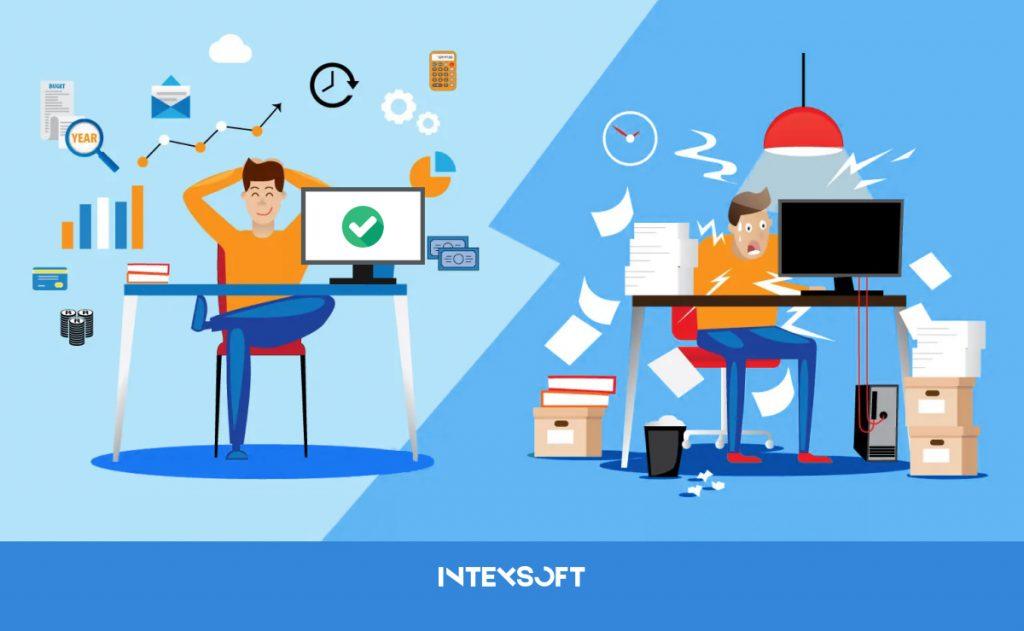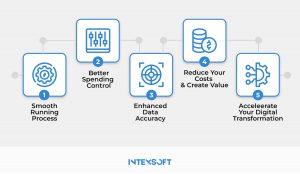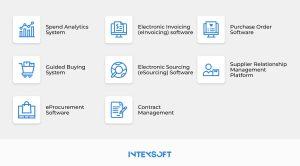
Here is an introduction to automated procurement software that outlines the best practices to ensure operational transparency and streamline manual processes.
Reading time: 25 min.

Ensuring maximum operational transparency as well as automating time-consuming manual processes is a real trend in the business world in recent years. You can see these changes virtually in all fields, and even in government sectors, but these advances can be especially useful in retail and e-commerce, and greatly facilitate decision-making processes.
Manufacturers, suppliers, sellers and end consumers – with so many players, businesses in these niches include a lot of working elements, such as order collection, production, testing, supply, delivery, and selling. The gap or negligence in one link may cause some troubles for the business owner, who usually doesn’t delve deeply in each minor operation. What’s more, it takes a great deal of time for them to organize an effective supply chain, from the moment of creating a purchase requisition up to the product marketing. However, by implementing procurement automation systems, businesses can mitigate risks, reduce manual errors, and streamline their operations, ensuring a smoother and more efficient workflow.
That’s why more and more trading entrepreneurs have started to implement a procurement system in real-time and improve the productivity of their procurement teams as soon as possible. What do they get as a result of that?
For those who are not already familiar with this sophisticated term, we’ll give a simple explanation: automated procurement systems are software synchronizing all components and sides of the supply chain. Typically, this system сonsists of three crucial parts: operational department ordering systems, e-markets, and vendor websites. By integrating it into an e-commerce business and procurement teams, you not only automate the routine and time-intensive tasks (getting orders, paying to suppliers, invoicing to buyers), but you can also manage your procurement process in a more effective, predictable, transparent, and secure way.
For example, automating your procurement with a procurement system provides you with real-time information on buyers’ needs, supplier quotes, and order history. This allows you to swiftly establish contracts with sellers for automatic shipment of goods, ensuring that consumer favorites are replenished promptly when their stocks reach zero. Your business can gain much more benefits from automated processes.
Procurement automation systems have revolutionized multiple industries, including education apps for communication and HR software development. These systems enable efficient procurement processes, allowing organizations to streamline their human resources management and enhance overall productivity. Whether it’s a system for a small business or a large enterprise, automated procurement solutions offer the benefits of robotic process automation, reducing manual tasks.
Procurement automation software offers key advantages to the procurement team, including improved efficiency, streamlined purchasing process, enhanced visibility, and better control over the procurement cycle.


When deciding to introduce the procurement system into your own business and achieve cost savings, it is crucial to understand what type of software will fit, first of all, your procurement workflows and your business needs. We’ll touch on nine areas where this technological innovation can help your company and share examples of procurement automation systems to cover those business directions, mitigating market risks:
Your spending equals how much you spent on production and sales, which also includes the total consumed resources, the labor costs, etc. The lower the costs are, the higher the effectiveness of the production is and the greater profit your enterprise gets after purchase requisitions and purchase orders. The main spend analysis tasks of the procurement automation system are:
Such an analysis is truly indispensable in case of the incomprehensible profit decreasing tendency to figure out the “black hole” the majority of your costs go to, which not only helps identify the root cause but also saves time. For example, if you released a new series of goods expected to be more profitable than the previous one, but despite its high popularity, your budget is still stuck in neutral, these automated procurement systems can swiftly identify the issue, including any maverick spending, allowing you to address it promptly and effectively. By implementing automated procurement systems, businesses can gain better visibility into their spending patterns and mitigate any upfront investments that may be causing financial strain.
Examples: Ariba, Ivalua, JAGGAER
Not so long ago, there were practically no services providing supplier lists, but with the emergence of cloud-based automated procurement systems, this issue doesn’t bother entrepreneurs anymore. In special built-in catalogs, you can find thousands of reliable candidates with reviews and ratings. With these cloud-based solutions, you can instantly connect with best suppliers, ready to compete for your business, and help reduce your supply costs and risks. The entire process takes little time. Simply structure your requirements, review proposals, and select the most suitable supplier to meet your needs, build long-term relationships with a clear line of disclosure, leveraging cloud-based procurement software. These systems extend their benefits not only to vendor relationships, but also to other areas of procurement.
Examples: Ariba, ThomasNet, APEX Analytix
When managing purchases, you can face such a challenge as the necessity of optimizing business processes, due to the company growth and individual workflow complication. You can feel a lack of transparency during the work with suppliers and you strive to ensure that purchases are carried out at optimal prices, while the goods are of good quality, the warehouse is not filled, and everything is delivered on time. How do you solve these problems?
Supplier relationship management solutions, as a part of the procurement software, allow you to reduce costs, minimize risks in dealing with suppliers, build a positive connection with them, and systematize the operations of purchasing goods and services within the company. The SRM concept not only benefits the procurement department, but also extends its advantages to other departments within the organization. It increases the transparency of transactions, meets all regulatory requirements related to the procurement process, and helps to select the most reliable suppliers for the goods and services needed by other departments. It streamlines invoice management, enables supplier evaluation, and reduces manual data entry tasks. As a result, the procurement function adequately fulfills its strategic role.
Examples: Ariba, MasterControl
E-sourcing is an electronic auction of the reverse type, where suppliers compete to provide the customer (initiator of the competition) with the lowest price. You can take part in a tender via the procurement software or get access to specialized websites. With this approach, the bidding occurs in real time with limited frames. This leads to a dynamic, fierce competition and, therefore, allows the buyer to get the best prices quickly. Additionally, the integration of the procurement software with the accounts payable system ensures seamless payment processing and reconciliation. This streamlined process eliminates manual entry errors and enhances the accuracy and efficiency of financial transactions.
It’s a perfect solution for business owners who want to analyze and choose suppliers in the price-quality ratio in less time, even for indirect purchases when your resources are exhausted.
Examples: GEP, Coupa Procurement, Zycus iSource
Contract management systems (CMS) offer significant benefits over manual contract management processes. It was not possible until recently to effectively monitor purchase requisitions. But now you can give a try to a contract management system to execute customer orders and plan purchases more competently, saving time. This software keeps information about potential and existing customers, sales volumes, and competitors. Additionally, it streamlines contract creation, tracking, and management, automates repetitive tasks, and enhances overall efficiency in procurement operations. By utilizing a contract management system, you can ensure better compliance with contract terms and improve the accuracy and effectiveness of your procurement processes. It eliminates the need for manual procurement and boosts accuracy.
It’s an automation tool for most sophisticated projects involving contractors who refuse to use paper format, particularly when dealing with low-value contracts. Such a system allows you to monitor numerous activities with cost implications and can be especially helpful for automating administration, guaranteeing compliance, tracking risk, running reports, and triggering alerts. In addition to these possibilities, contract management software provides a centralized repository for workers to access all contracts worldwide in one place immediately. This streamlines the sourcing process, eliminates manual processing, and enables effective evaluation of vendor performance.
For example, it can come in handy when analyzing contractors’ authority and decency to define who would be better to end purchase requisitions and any relationship.
.
.
Online purchases are gaining immense popularity, encompassing both goods and services. The convenience and ease of buying services through the e-procurement system mirror the experience of purchasing goods, streamlining the procurement processes. This trend highlights the growing acceptance and adoption of online platforms for procuring a wide range of products and services. The difficulty here may be that the recommendations and feedback of colleagues guide many customers, not the market research. However, the rich database and broad possibilities of automated procurement systems, including supplier information, will help you choose the best offer with a limited number of participants. This means that instead of conducting a year-long market analysis, you can find a suitable supplier through weekly auctions without the fear of engaging with an unskilled or unreliable candidate. This not only saves time but also enhances existing workflows and supplier performance assessment.
Example: Coupa Procurement, ProcurePort, eBid
The idea of e-invoices originates from the moment of an increasingly popular paperless trading tendency. Automating the procurement process with electronic invoicing offers a low-cost transaction processing model that effectively applies digital technology to transform the manual and paper billing process into a faster and more convenient electronic messaging and accounting system. That’s why e-Invoicing is what your procurement team needs.
In terms of logistics, record keeping, and ordering cycle time, the adoption of electronic invoicing significantly reduces the reliance on paper for documenting and storing payment information. By issuing electronic invoices, sellers get rid of a large amount of manual data entry. They can save effort in printing, mailing, recording, saving, and reconciling paper invoices. The adoption of e-invoicing standards scales down sending cycles. In addition, timely notifications and invoice status updates, faster invoice transfer for payer approval process, and dispute resolution systems improve customer service. Payers receive regular messages on the status of invoices and payment terms, which allows them to estimate cash outflows with greater certainty and manage their capital more efficiently. Apart from that, automated invoice approvals streamline the payment process, reducing delays.
Examples: FreshBooks, Xero, Zoho Invoice
Having an integrated procurement system is crucial for streamlining business-critical activities. Buying companies can efficiently pay suppliers using the procure-to-pay (P2P) model, which differs from the traditional approach of using an ERP system. However, users are provided with a convenient combination option allowing them to add a source-to-pay solution to solicit quotes from suppliers. This ultimately can save time in managing supplier payments and procurement operations.
Examples: Ivalua, Puridiom
Some automated procurement systems offer the majority of the possibilities presented, described above in one software. Such a combination of features is called a suite, and it’s up to you what procurement function to choose. Utilizing a suite can help streamline the procurement process, increase efficiency, and mitigate the potential for human bias.
Examples: Tradogram, Bellwether, SAP SRM, TradeGecko, Ariba, GEP
In case the tools mentioned above do not meet the specific requirements of your procurement function, it is advisable to consider the development of a custom automated procurement system. Let’s look through the details of one of such projects developed by our team.
Out-of-the-box solutions are a great opportunity to optimize the procurement processes every company should automate. But there are cases when a company’s procurement team requires a custom solution with a particular set of features catering to the business specifics.
A couple of years ago one of our clients reached out to IntexSoft for a customized solution. The client is a German based company that operates in more than 40 countries worldwide and includes several enterprises.
The company needed to develop an automated system for holding tenders and integrate it with an internal corporate application for product supply chain monitoring. One of the core requirements was configuring the system to work in two modes: participant mode (search for tenders based on a set of parameters) and organizer mode (selection of participants, regulations control, bidding, winner determination, etc.). This solution aimed to enhance the company’s tendering process and streamline the management of its product supply chain, while also ensuring effective record keeping and compliance with regulations. It effectively mitigates operational risks and improves overall procurement efficiency.
To develop the system from scratch, we gathered the team of specialists:
We developed a web app which automated business processes related to the creation of tenders. First of all, we developed in accordance with set conditions. First of all, the IntexSoft team developed an automatic search for suitable tenders in accordance with the conditions set. The app also provides notifications and alerts for new tender opportunities, streamlining the accounts payable process.
IntexSoft developers also implemented a feature for analyzing tender terms for keywords that must be entered into the system beforehand, ensuring compliance with specific requirements and minimizing compliance issues in procurement processes. Based on the search results and analysis of the received data, the system can issue reports on the managers’ working efficiency, work with tenders for a certain period of time, total amounts of successful tenders, and other aggregated data.
After all the features were ready, we synchronized the system successfully with the internal software for tracking product supply chains, streamlining and enhancing the current processes. Thanks to this, our client can easily integrate projects from the supply chain software and automatically create and launch tenders.
While project development, our team followed the Scrum methodology, ensuring an iterative and collaborative approach to the procurement processes. At the end of each sprint, the Project Manager from our side organized a project review to gather feedback from the client and discuss further application improvements. The feedback received during these reviews was crucial in refining the features and functionalities of the automated procurement system. Additionally, a central repository was set up to store all project-related documentation, including meeting minutes, user stories, and design specifications.
To ensure data security and protect sensitive information, we implemented HTTPS protocols and encryption throughout the entire procurement workflow. This ensures that all interactions with the program are secure, giving business leaders peace of mind regarding the confidentiality and integrity of their data.
| Front-end | Apache Wicket |
| Back-end | Java, Hibernate, Spring, Maven |
| Database | MySQL |
Have a need for right procurement process automation with bespoke software products? Contact us and we’ll discuss possible automated procurement systems for your business.
In conclusion, procurement automation systems are key in optimizing business procurement workflows. By integrating systems to automate purchase orders or purchase requisition forms, businesses can achieve significant benefits such as improved efficiency of the purchasing process, reduced manual and repetitive tasks, enhanced vendor management, and better control over the procurement cycle. With these systems, the procurement department can automate and manage purchase orders more effectively.
Now you have a general understanding of the incredible opportunities cloud-based automated procurement systems open for commerce entrepreneurs and most organizations to address procurement issues. They change the traditional way of managing a supply chain and can help boost your profit through an optimized and transparent workflow. With the availability of digital forms and an abundance of procurement solutions on the market, you can improve strategic planning and a digital revolution of your procurement team and your business right now.